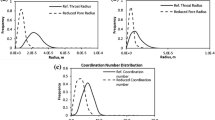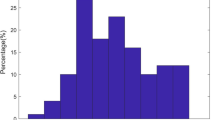Abstract
We predict capillary-pressure (drainage) curves in tight-gas sandstones which have little matrix or microporosity using a quantitative grain-scale model. The model accounts for the geometric results of some depositional and diagenetic processes important for porosity and permeability reduction in tight-gas sandstones, such as deformation of ductile grains during burial and quartz cementation. The model represents the original sediment as a dense, disordered packing of spheres. We simulated the evolution of this model sediment into a low-porosity sandstone by applying different amounts of ductile grains and quartz precipitation. A substantial fraction of original pore throats in the sediment is closed by the simulated diagenetic alteration. Because the percolation threshold corresponds to closure of half of the pore throats, the pore space in this type of tight-gas sandstone is poorly connected and is often close to being completely disconnected. The drainage curve for different model rocks was computed using invasion percolation in a network taken directly from the grain-scale geometry and topology of the model. Some general trends follow classical expectations and were confirmed by experimental measurements: increasing the amount of cement shifts the drainage curve to larger pressures. This is related to reduction of the connectivity of pore space resulting from closure of throats. Existence of ductile grains in the ductile grain model also reduces the connectivity of pore space but it treats the throats distribution differently causing the drainage curves to be shifted to larger irreducible water saturation when cement is added to the model. The range of porosities in which these connectivity effects are important corresponds to the range of porosities common for tight gas sandstones. Consequently these rocks can exhibit small effective permeability to gas even at large gas saturations. This problem occurs at larger porosities in rocks with significant content of ductile grains because ductile deformation blocks a significant fraction of pore throats even before cementation begins. Predicted drainage curves agree with measurements on two samples with little microporosity, one dominated by rigid grains, the other containing a significant fraction of ductile grains. We conclude that connectivity of the matrix pore space is an important factor for an understanding of flow properties of tight-gas sandstones.
Similar content being viewed by others
References
Al-Raoush R., Thompson K.E., Clinton S.W.: Comparison of network generation techniques for unconsolidated porous media. Soil Sci. Soc. Am. J. 67(6), 1687–1700 (2003)
Behseresht, J.: Infinite acting physically representative networks for capillary-controlled displacements. A thesis submitted to Department of Petroleum Engineering and Geosystems of University of Texas at Austin in partial fulfillment of Master of Science in Engineering (2008)
Behseresht J., Bryant S.L.: Sedimentological control on saturation distribution in Arctic gas-hydratebearing sands. Fire in the Ice 11(1), 10–12 (2011)
Behseresht, J., Peng, Y., Prodanovic, M., Bryant, S.L.: Grain scale study of hydrate formation in sediments from methane gas: role of capillarity. In: Proceedings of the 6th International Conference on Gas Hydrates, Vancouver, BC, Canada (2008)
Behseresht J., Bryant S.L., Sepehrnoori K.: Infinite-acting physically representative networks for capillary-controlled displacements. SPE J. 14(4), 568–578 (2009)
Bryant S.L., Mason G., Mellor D.: Quantification of spatial correlation in porous media and its effect on mercury porosimetry. J. Colloid Interface. Sci. 177, 88–100 (1996)
Bryant S.L., Cade C., Mellor D.: Permeability prediction from geologic models. AAPG Bull. 77(8), 1338–1350 (1993)
Bourbie T., Zinszner B.: Hydraulic and acoustic properties as a function of porosity in fontainebleau sandstone. J. Geophys. Res. 90, 11524–11532 (1985)
Dutton, S.P., Clift, S.J., Hamilton, D.S., Hamlin, H.S., Hentz, T.F., Howard, W.E., Akhter, M.S., Laubach, S.E.: Major low-permeability sandstone gas reservoirs in the continental United States (Report of Investigations No. 211). University of Texas at Austin, Bureau of Economic Geology (1993)
Finney, J.: Random packing and the structure of the liquid state. A dissertation submitted to Department of Earth Sciences of University of London in partial fulfillment of the requirements for the degree of Doctor of Philosophy (1968)
Fisher R.A.: On the capillary forces in an ideal soil; correction of formulae given by W.B. Haines. J. Agric. Sci. 16, 492–505 (1962)
Gladkikh M., Bryant S.: Prediction of imbibitions in unconsolidated granular materials. J. Colloid Interface Sci. 288, 526–539 (2005)
Haines W.B.: Studies in the physical properties of soil. V. The hysteresis effects in capillary properties and the modes of moisture distribution associated therewith. J. Agric. Sci. 20, 97–116 (1930)
Houseknecht D.W.: Influence of grain size and temperature on intergranular pressure solution, quartz cementation and porosity in a quartzose sandstone. J. Sed. Petrol. 54(2), 348–361 (1984)
Jin, G., Patzek, T.W., and Silin, D.B.: Modeling the impact of rock formation history on an evolution of absolute permeability. In: SPE annual technical conference and exhibition, Houston, TX (2006)
Joekar-Niasar V., Prodanović M., Wildenschild D., Hassanizadeh S.M.: Network model investigation of interfacial area, capillary pressure and saturation relationships in granular porous media. Water Resour. Res. 46, W06526 (2010)
Mason G.: Desaturation of porous media. I. Unconsolidated materials. J. Colloid Interface Sci. 41(2), 208–227 (1972)
Mason G., Mellor D.W.: Simulation of drainage and imbibitions in a random packing of equal spheres. J. Colloid Interface Sci. 176, 214–225 (1995)
Mehmani, A., Tokan-Lawal, A., Prodanović, M., Sheppard, A. P.: The effect of microporosity on transport properties in tight reservoirs. In: SPE unconventional gas conference, Woodlands, TX (2011)
Mellor, D.W.: Random close packing (RCP) of equal spheres: structure and implications for use as a model porous medium. A dissertation submitted to Department of Earth Sciences of Open University, United kingdom in partial fulfillment of the requirements for the degree of Doctor of Philosophy (1989)
Milliken, K.L., Choh, S.-J., McBride, E.F.: Sandstone Petrology, v. 2.0, A Tutorial Petrographic Image Atlas, Multimedia CD-ROM: American Association of Petroleum Geologists/DataPages, Discovery Series No. 10 (Second Edition), Tulsa, Oklahoma, CD-ROM (2007)
Mousavi, M.A., Bryant, S.L.: Geometric models of porosity reduction by ductile grain compaction and cementation. AAPG Bull., submitted (2011)
Mousavi, M.A.: Pore scale characterization and modeling of two-phase flow in tight gas sandstones. A dissertation submitted to Department of Petroleum Engineering and Geosystems of University of Texas at Austin in partial fulfillment of the requirements for the degree of Doctor of Philosophy (2010)
Mousavi, M.A., Bryant, S.L.: Geometric models of porosity reduction mechanisms in tight gas sands. In: SPE rocky mountain oil and gas technology symposium, Denver, CO (2007)
Roberts J.N., Schwartz L.M.: Grain consolidation and electrical conductivity in porous media. Phys. Rev. B. 31(9), 5990–5997 (1985)
Sakhaee-Pour, A.: Gas flow through shale. A dissertation submitted to Department of Petroleum Engineering and Geosystems of University of Texas at Austin in partial fulfillment of the requirements for the degree of Doctor of Philosophy (2012)
Thane, C.G.: Geometry and topology of model sediments and their influence on sediment properties. A thesis submitted to Department of Petroleum Engineering and Geosystems of University of Texas at Austin in partial fulfillment of Master of Science in Engineering (2006)
Valvatne P.H., Blunt M.J.: Predictive pore-scale network modeling of two phase flow in mixed wet media. Water Resour. Res. 40, W07406 (2004)
Worden, R.H., Morad, S.: Quartz Cementation in Sandstones. International Association of Sedimentologists Special Publications 29. Blackwells, Oxford (2000)
Author information
Authors and Affiliations
Corresponding author
Additional information
This article was previously presented in AAPG Annual Convention and Exhibition, June 7–10, Denver, Colorado, 2009.
Rights and permissions
About this article
Cite this article
Mousavi, M.A., Bryant, S.L. Connectivity of Pore Space as a Control on Two-Phase Flow Properties of Tight-Gas Sandstones. Transp Porous Med 94, 537–554 (2012). https://doi.org/10.1007/s11242-012-0017-x
Received:
Accepted:
Published:
Issue Date:
DOI: https://doi.org/10.1007/s11242-012-0017-x




